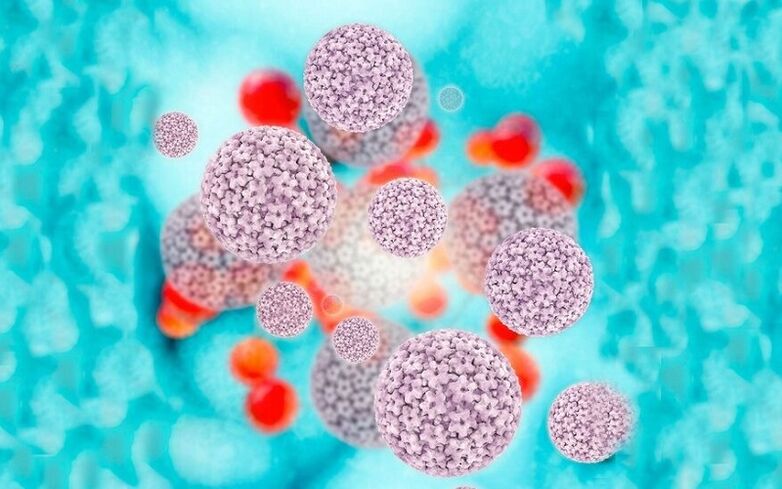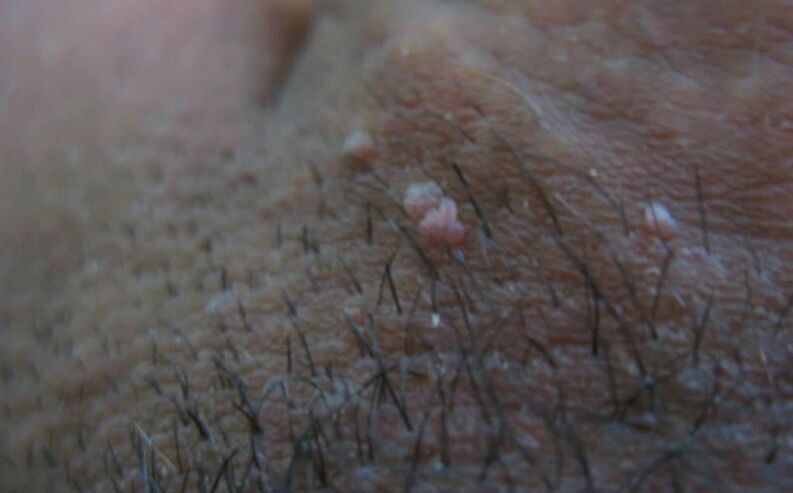Papilloma on the labia is a very subtle problem that can cause dissatisfaction with oneself and a decline in the quality of sexual life. They are difficult to hide and cause inconvenience during sexual intercourse, so the papilloma should be removed. In addition, in some cases, the growth of female genitalia may be a dangerous risk of cancer.
Causes of papilloma formation
Papillomas on the labia or genital warts are the result of human papillomavirus infection. There are a total of more than 100 strains of this virus, and their difference lies in the type of tumor and the degree of risk of tumor development.
Against the background of reduced immunity, the virus enters the human body mainly through sexual contact. At the same time, men who have infected women may not have obvious signs of the virus, because men's papilloma does not always appear on the skin.
Immunity decline occurs in the context of recently transferred infectious diseases, vitamin deficiency or chronic stress. The papilloma on the labia may be caused by various inflammations of the reproductive organs and infectious diseases (including thrush and bacterial vaginosis) that lead to a decrease in local immunity. At the same time, for infection, it is sufficient to use other people's personal hygiene products, so that unsightly vegetation will appear on the labia after a period of time.
Therefore, although the virus can spread from one person to another, the causes of papilloma on the labia of women are as follows:
- Decreased immunity after ARVI, pneumonia, influenza or tonsillitis;
- Vaginal infections;
- Not paying attention to personal hygiene;
- pressure;
- Unbalanced diet;
- There are chronic infection foci in the body;
- Promiscuity.
All of these factors will lead to a decline in overall and local immunity. Therefore, the body is susceptible to various negative effects and cannot resist the human papilloma virus.
In many cases, the virus does not manifest itself, but is limited by the body's immunity. This is only true if the person is perfectly healthy. Then the virus can remain asymptomatic in the body for a long time. The formation of papilloma will occur against the background of decreased immunity. If this does not happen in the next few years, the body can deal with the virus on its own, but it usually takes at least 18 months to heal itself.

What is a papilloma on the genitals?
The manifestation of female labia infection depends on the following factors:
- Virus type
- The concentration of the virus in the body;
- Localization of growth.
The formation of labia minora papilloma is caused by the influence of the carcinogenic or conditionally carcinogenic strains of the virus (16, 18, 31, 32, 45 and other types). Knowing what genital warts are, it is easy to understand the appearance of this papilloma on the labia. These are small papillae with jagged edges, located above the mucosal surface. They usually have no difference in color or are slightly lighter than mucous membranes. The manifestation of papilloma virus on the labia can cause the development of genital warts, which can spread to the perineum, vulva, and vagina of women.
Condyloma acuminatum always only forms on the mucous membrane. Papillomas on the inner labia of women do not appear, they only form in areas with thin epidermis.
Papilloma is a small ball on the leg that is higher than the skin. They have smooth borders of the correct shape and may be slightly lighter or darker than the rest of the skin. When pressed, the papilloma on the labia is not painful, and the uniform structure of growth is felt under the fingers. This type of tumor appears on the groin folds and labia majora.
Almost all known methods are used to remove papillomas on the labia, because the risk of burns or deep damage to the epidermis is small. The treatment of papilloma of the labia minora is done in a comprehensive manner because this growth is potentially dangerous.
Warts can form in the following areas:
- Labia minora
- vulva;
- vaginal;
- cervix;
- Anal opening
- crotch;
- Urethra.
The photo of labial papilloma is indistinguishable from the growth images of other parts of the body, while papillomas or condyloma acuminata in the vagina and vagina are difficult to notice individually.
The formation of papilloma on the labia during pregnancy is related to the decline of immunity. In this case, the consequences of timely treatment of HPV play an important role, otherwise the child will be at risk of infection when passing through the birth canal.

Why is papilloma dangerous?
Sexual contact is directly related to the human papillomavirus on the labia of women. First, after contact with the affected mucosa, there is a risk of transmitting the virus to sexual partners. Secondly, rubbing during sexual intercourse can damage papilloma and condyloma acuminata, and is accompanied by pain. There is a risk of contracting papilloma, and it will become inflamed and begin to degenerate into cancer.
In some cases, due to repeated injuries, women have a huge papilloma on the labia majora. No woman will be insured for this risk. Large growth is very dangerous and should be removed first.
Papilloma of the labia minora and vagina can lead to the development of cervical cancer. This is due to the activity of the papilloma virus, which is manifested by the excessive division of epithelial cells in the labia minora and other parts of the mucosa. In this case, the damage to the cervical cells develops in several stages. First of all, because HPV forms erosions on the labia, it then turns into dysplasia, which is a precancerous lesion. Failure to treat dysplasia in time leads to the development of cervical cancer.
It should be understood that any papillomas on the labial mucosa are potentially dangerous. Papilloma itself can degenerate into cancer, not only can cause cervical cancer. Signs of malignant papilloma are increased growth in size, pain and itching, discharge of unpleasant odors from the growing body, and darkening of the skin in the affected area. If you notice such symptoms, you should consult a doctor as soon as possible—oncologist, gynecologist or dermatologist.
Treatment and removal of papilloma
How to treat papillomas on the labia depends on their number and size. It is recommended not to self-administer medication, but to consult a doctor, who will tell you in detail how to remove and prevent the reappearance of labial papilloma.
The removal of papilloma on the labia should be consistent. First, inhibit the activity of the virus, then remove the growth itself, and if necessary, perform immunostimulation therapy. To accurately determine the order of treatment, PCR analysis should be used, which can show the degree of activity and concentration of the virus, and also determine its strain.
If a woman is found to be infected with a potentially dangerous strain of the virus (16 or 18 years of age), complex treatment is required. In this case, each papilloma removed will be sent for histological analysis and a comprehensive examination of the cervix to understand the changes in the epithelium.
How to remove the papilloma on the labia depends on the exact location. Remove skin tumors in any available way-from surgery to civil. This is because the skin of the labia majora is thick enough, so there are few complications after removal. To be fair, in most cases, the formation on the labia majora is not harmful to health, nor does it cause cancer.
With the help of laser irradiation or radio wave methods, the genital warts on the mucous membranes are removed. These two methods are considered to be the most gentle, and at the same time they do not block the nourishing and growing blood vessels, so the risk of bleeding is small. When a tumor is removed from the cervix or vagina, histological analysis is required to rule out the pathological process.

You should consult your doctor about how to remove papilloma on the labia. If the analysis shows that the virus concentration in the body is very high, there is a risk of re-forming condyloma acuminatum, so comprehensive treatment includes three stages.
- After identifying the virus strain, the woman received antiviral and immunomodulatory treatment. This is necessary to suppress the virus and minimize the risk of re-formation of papilloma.
- After an average of several weeks of medical treatment, the papilloma will be removed using a method selected and agreed with the doctor. It is recommended to use laser removal or radio wave methods.
- After the growth has been removed for a period of time, the analysis should be repeated. If the virus concentration is still high, a second course of medication is prescribed.
Medications used to treat papilloma are available in the form of tablets and ointments. It is recommended to use antiviral ointments with immunomodulatory properties to treat papilloma on the skin. If growths appear on the mucous membranes, it means taking a pill.
Usually, after removal of the papilloma and medical treatment, the body will heal on its own within a few months or years. In order to avoid the re-formation of papilloma, women must abide by hygiene rules, maintain their own immunity, and avoid unprotected sexual intercourse.














































































